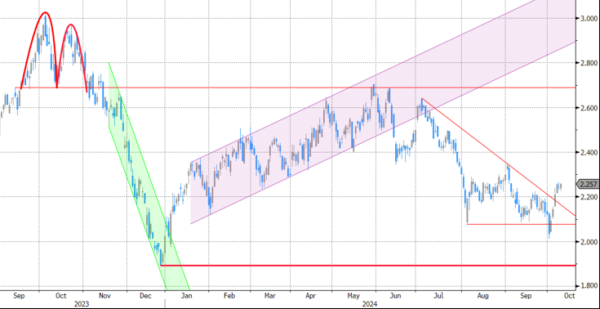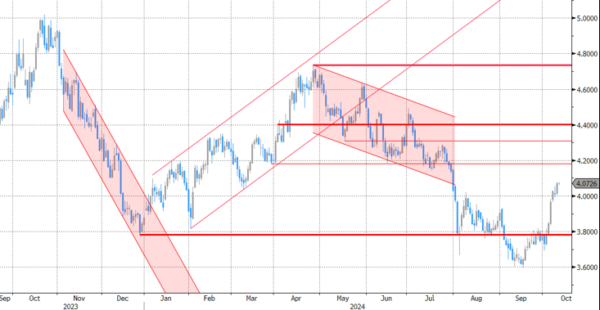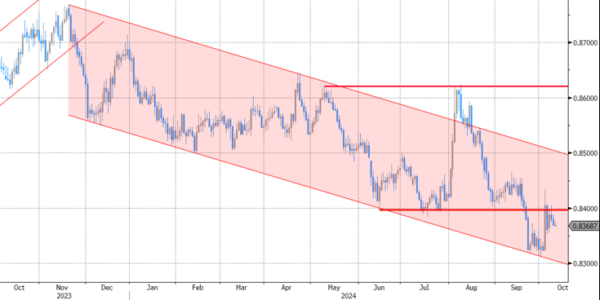Markets
Yesterday’s risk-on sentiment, Fed comments and the release of the Minutes of the Fed September meeting all contributed to a gradual, but protracted intraday uptrend in US yields. They closed higher between 7.1 bps (5-y) and 4.7 bps (30-y). Fed comments (Daly, Logan) suggest most governors see inflationary pressures receding while risks to employment are growing, despite Friday’s US payrolls report. The minutes of the September 17-18 meeting also showed some internal debate on the need for a 50 bps inaugural step. Some participants would have preferred a 25 bps reduction and few other embers indicated that they could have supported such a decision. In this respect, the also indicated that a 25 bps ‘reduction would be in line with a gradual path of policy normalization that would allow policymakers time to assess the degree of policy restrictiveness as the economy evolved.’ Markets now pricing in slightly less than 50 bps of cumulative cuts for the two remaining meetings of this year can be considered as more or less in line with the aim of gradualism. Of course, the Fed works in a status of data-dependency. German yields added 3.2 bps (2-y) to 0.4 bps even as ECB governors show a ‘near-consensus’ on a 25 bps step next week, with ECB Kazimir one of the exceptions the rule. Especially US equities still feel supported by the combo of decent growth and the prospect of (gradual) policy easing. The S&P 500 (+0.71%) closed at a new record (5792.04). After some hesitation earlier this week, the dollar is gradually regaining traction, moving further beyond the resistance levels broken in the wake of last week’s strong US eco data. EUR/USD closed at 1.094. DXY at 102.93.
Asian markets mostly remain in risk-on mode this morning. Mainland China investors are looking forward to a press conference by the China’s Finance Minister on Saturday that should bring some clarity on the amount of (fiscal) stimulus. Later today, attention shifts to the US September CPI release. Consensus expects headline inflation to ease to 0.1% M/M and 2.3% Y/Y (was 0.2% M/M and 2.5% Y/Y) and core inflation at 0.2% M/M and 3.2% (was 0.3%, 3.2%). The market and Fed focus recently turned from inflation to growth. We assume that a big upward surprise is needed for markets to again reconsider this shift. With markets not fully discounting two additional 25 bps steps for the two remaining Fed meetings this year, the room for a further rise in short-term US yields might become limited. LT yields maybe still have some further upside in case of solid data or as the focus turns to fiscal policy in the run-up the US election. In theory, this also should be a rather neutral set-up for the dollar. However, the technical picture in most USD cross rates is improving. EUR/USD 1.0881/82 (76% retr. since early August/correction low) is the next intermediate target on the charts.
News & Views
The People’s Bank of China announced details of the swap facility which was part of the broader support package launched on September 24. Eligible brokers and insurers can now pledge assets with the Chinese central bank such as bonds, stock ETF’s and shares of companies listed on the CSI 300 in return for liquid assets. The size is CNY 500bn but may be expanded in the future. The announcement helps Chinese stock markets 3% to 5% higher this morning, extending their volatile ride. USD/CNY tries to break with the post-payrolls USD-strength that pulled the pair away from 7-area (lowest since May 2023) to currently 7.07. Focus now turns to a press conference by Finance Minister Lan Fo’an on Saturday with more (details on) fiscal stimulus expected.
The New Zealand Department of Treasury published financial government statements for the year ended 30 June 2024. The deficit was NZD 12.85bn, compared to NZD 11.07bn projected in the May budget. That’s an increase from the NZD 9.45bn deficit in the 2022/2023 financial year. Finance Minister Willis warned that the books are not in great shape and wants to tidy them up. She targets a return to budget surplus in 2028 and wants to reduce debt to less than 40% of GDP (42.5% of GDP end June). According to the budget forecasts, the deficit will widen further to NZD 13.37 bn in the year through June 2025 before starting to narrow.
Graphs
GE 10y yield
The ECB cut policy rates by 25 bps in June and in September. Stubborn inflation (core, services) still is a source of concern, but very weak PMI’s and soft comments of Lagarde (and other MPC members) suggest the ECB is likely to step up the pace of easing with an October cut. Spill-overs from strong US data prevented a test of the 2.0% barrier. 2.00-2.35% might serve as a ST consolidation range.
US 10-y yield
The Fed kicked off its easing cycle with a 50 bps move. Powell and Co turning the focus from inflation to a potential slowdown in growth/employment made markets consider more 50 bps steps. Strong US September payrolls suggest the economy doesn’t need aggressive Fed support for now, but the debate might resurface as the economic cycle develops. For the US 10-y, 3.60% serves as strong support. The steepening trend is taking a breather.
EUR/USD
EUR/USD twice tested the 1.12 big figure as the dollar lost interest rate support at stealth pace. Bets on fast and large rate cuts trumped traditional safe haven flows into USD. An ailing euro(pean economy) partially offset some of the general USD weakness. After solid early October US data, the dollar regained traction, with EUR/USD breaking the 1.1002 neckline. Targets of this pattern are near 1.08.
EUR/GBP
The BoE delivered a hawkish cut in August. Policy restrictiveness was indicated to be further unwound gradually. The economic picture between the UK and Europe also (temporarily?) diverged to the benefit of sterling, pulling EUR/GBP below 0.84 support. Dovish comments by BoE Bailey ended by default GBP-strength. Uncertainty on the UK budget to be released end this month is becoming an additional headwind for the UK currency.

















